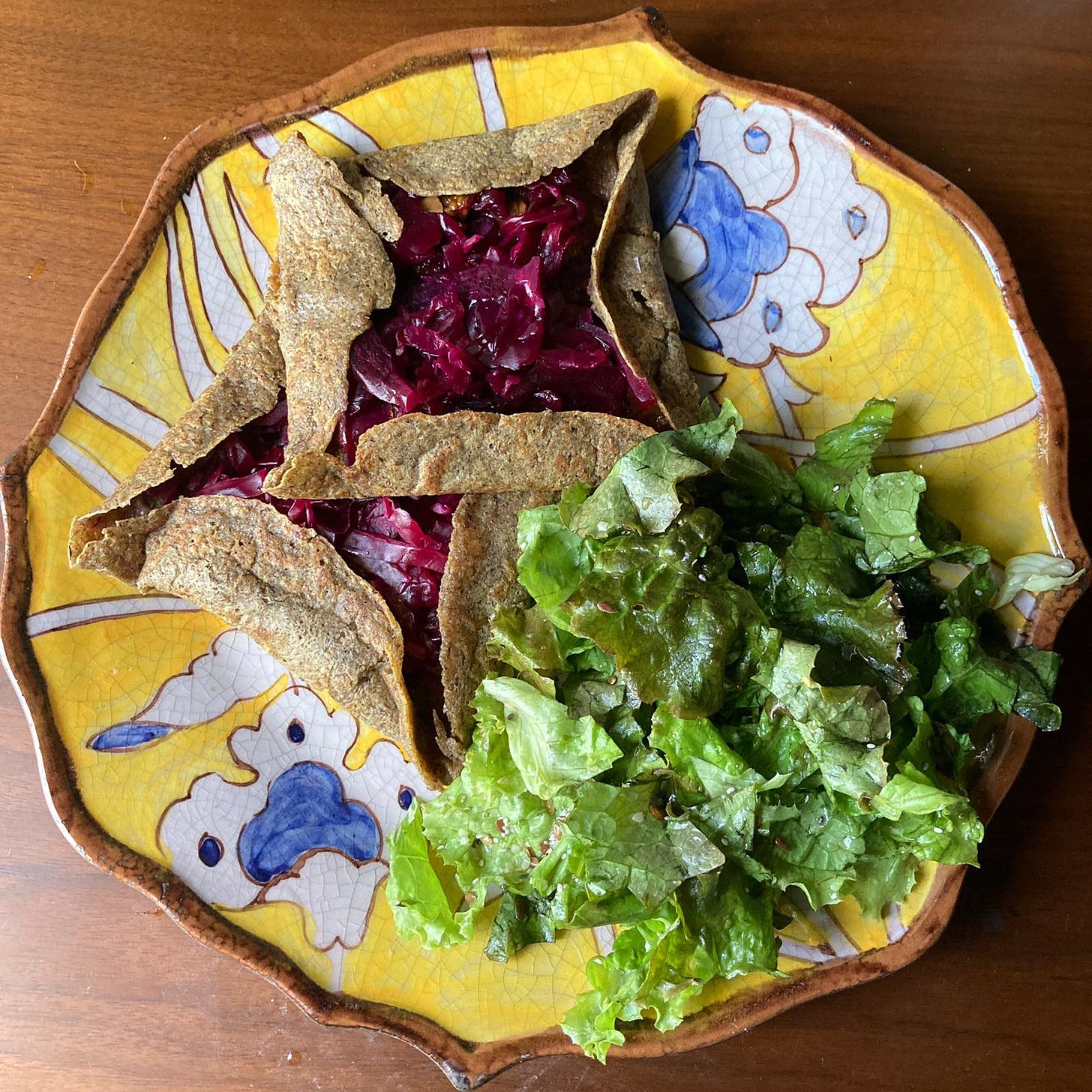Sunshine + Microbes is back! We hope you found joy in Jackie’s simple yet sumptuous garlic recipes while we were away.
If someone shared this newsletter with you, subscribe below.

I felt an exhilarating, solitary breeze this weekend — the first in months. My heart leapt at the prospect of this interminable summer of 2020 drawing to a close. One bright spot on the horizon is tending to my new backyard garden beds, built by my stunningly capable friend Hannah. It’s tough to grow veggies during the summer in South Florida, due to the intense heat and heavy rains (which make plants more vulnerable to pests and disease). The cooler, drier weather I dream about is also ideal for crisp lettuce, juicy tomatoes, vibrant herbs, sweet strawberries, and the many joys of the South Florida growing season, which extends from mid-to-late September all the way through mid May (climate chaos-dependent, of course).
I am a moderately lazy person with an exceptionally high tolerance for messiness. Knowing this allows me to set appropriate expectations for my home gardening endeavors. I will not be weeding daily. I’ll call it a win if I fertilize (with fish parts!) and spray for pests (with soap!) once a month. My garden will be messy. The veggies I harvest, due to my lack of careful attention, will be far from perfect. But perfection is for suckers, and the food is still gonna taste good y'all. Tis a simple joy to harvest some arugula and cherry tomatoes, quickly toss with lemon, salt, and olive oil (and honey and shaved parm if you’re fancy), and immediately enjoy the freshest salad possible.
This season I plan to focus my efforts on a handful of greens (baby leaf lettuce, arugula, collards, and flat leaf kale), all the herbs I can get to grow, and a small selection of favorite veggies — fennel, cayenne peppers, heirloom cherry tomatoes, shelling beans, and a striped Italian eggplant. I’ll leave the more challenging veggies, like heirloom slicer tomatoes, to the pros.
I’m excited to grow food at home. This feels like a gift I can give to myself — a reminder of my agency in a chaotic world. I look forward to sharing the joys (and misfires) of the garden with all of you during the upcoming growing season.
love,
Jackie
Help us grow our garden 🌱and share Sunshine + Microbes:

Workshops
St. Pete Ferments makes a 🔥🔥🔥 hot sauce
Sarah Arrazola of St. Pete Ferments made her Wicked Jack Hot Sauce in the penultimate workshop for the Grow Roots Miami fundraiser. Watch her bring the heat 🥵
We have one more workshop to go, and we’re inviting EVERYONE to participate in this one. Save the date and link and join us Saturday! ⬇️
Fermenting Veggies with Susan Cartiglia of Radiate Kombucha | Saturday, September 12th at 10 a.m. | Zoom link
Fresh Links
🥒He Always Called Me Pickles | Food & Wine
Kim Kelly reflects on the way her reticent, blue collar farmer grandfather showed his love for his granddaughter. He always bought her pickles.
Dill pickles, brined in vinegar, became a beloved snack for Kelly in her childhood. Her grandfather — who never liked to let anyone get too close — took notice. He nicknamed her Pickles, and he always had spears in the fridge for visits. Kelly’s grandma would sometimes spot her husband surveying the jars in a store. In his “massive steelworker’s hands”, he’d look for the juiciest specimens to bring home.
Kelly admits her palate has long matured past those common store-bought pickles. But they remain an unforgettable memory when she remembers her grandfather, who passed this summer. She writes: “He doted on me as only a 6’4” barrel-chested former Marine can dote on a small blonde girl child, and if his Pickles wanted pickles, then only the best pickles would do.
🥞For female politicians, talking about cooking can be fraught. Kamala Harris is breaking that mold. | Washington Post
Kamala Harris has not shied away from her love of cooking while she rises in national politics. That hasn’t always been an easy thing for women to do:
Performance of domestic arts has always been a fraught dance for women in politics. First ladies have long been expected to offer cookie recipes, while female politicians have historically distanced themselves from the homemaking roles they struggled so long to shed. But Harris is refreshingly modern evidence that women in the public eye now can bake a gourmet cake and eat it, too
Harris expresses her Indian and Jamaican heritage in her recipes. She’s talked up her favorite Alice Waters cookbooks, taught a fellow senator how to make a tuna melt sandwich, and cooked masala dosas with Mindy Kaling.
Perhaps more impressive than her social media posts on Bolognese and cardamom-scented swordfish is that she has backed it up with a serious interest in food policy — marching with McDonald’s workers for higher-wages, supporting SNAP legislation, and being vocal about hazard pay for grocery workers in the pandemic. Refreshingly, Harris wants food to be part of her public persona as she campaigns on figurative and literal kitchen table issues.
🍄The Secret Lives of Fungi | New Yorker
Cultures across the globe — from Eastern Europe to Mexico — are mycophiles (fungus lovers). But the U.S. has always had a mycophobic streak. Hua Hsu writes about the wonders of fungi, and if attitudes are changing toward the mushroom kingdom.
From the expanding research in psilocybin trips to treat depression and other mental illnesses to the mainstreaming of home fermentation, fungus is having a moment in the United States. And that’s deserved, since for millions of years fungi have played a fundamental role in ecology by transforming organic matter into soil. Those special skills have resulted in a growing interest in mycoremediation, or using “fungi to remove toxic substances from the environment.” The examples are alluring:
Fungi have helped clean up diesel-contaminated soil; they’ve broken down pesticide residues, crude oil, and plastics. Disposable diapers can linger in a landfill for hundreds of years, but in 2014 scientists reported that they had grown oyster mushrooms on a substance made from used diapers, reducing their weight and volume by eighty percent. (And the mushrooms were safe to eat.) Mycelium is even capable of filtering E. coli or heavy metals from polluted water. [Author Merlin] Sheldrake describes a company in Finland that has adopted these mycofiltration techniques to reclaim gold from electronic waste. The firm Ecovative Designs has developed mycelium-based packaging that resembles Styrofoam but biodegrades within thirty days.
The mycophiles know it. The secret lives of fungi merit our attention and awe. There’s still much to learn from them. Like, um, this:



Sourdough Buckwheat Galettes

My very first experience with producing food for other people to buy was making galettes in rural France. I was 18 years old and wwoofing on a farm with a very kooky family who raised cows for milk and rabbits for terrine. They ran a micro bakery producing rustic sourdough bread and galettes, which are savory crepes made with buckwheat flour.
I turned out to be a galette-making savant. My bony wrists were made for quickly twirling the traditional wooden dowel around the batter to spread and shape the galettes. By the end of my short stay on the farm, the family let me produce tall, steaming stacks of the thin pancakes unsupervised. Visitors to the farm would buy their raw milk and pick up a dozen galettes to take home and fill with cheese and eggs for a traditional summer lunch.
For this week’s recipe, I made sourdough galettes. Think of them like a thin pancake you can top with whatever you want, and then fold in half and eat like a taco. Fill them with last night’s veggies, or shave some cheese and crack an egg and let it cook right on the pancakes.
Makes 3-4 servings
Ingredients and Special Tools
1/2 cup sourdough discard
1/2 cup buckwheat flour
1 large pinch salt
2 eggs
1/2 cup water
butter
fillings of choice (savory: cheese, eggs, veggies, meat; sweet: Nutella, banana and honey, sugar and lemon juice)
crepe spatula, or other long spatula (it will make the flipping the pancake much easier)
cast iron or non-stick pan
step-by-step
In a bowl, whisk together eggs and water. Add sourdough discard, flour, and salt and whisk until smooth. It should be thin — closer to creamy soup than traditional pancake batter. The mixture will thicken up a bit as it rests.
Cover and let rest in fridge for 2 hours, or up to several days. The longer it sits in the fridge, the flufflier the galettes will become.
Heat pan over medium high heat. Once surface is hot, melt a knob of butter. It should immediately sizzle. Move the pan around using the handle, tipping it in a circle so the butter coats the entire bottom and a bit of the sides.
Working quickly, pour batter in a spiral starting at the center. Immediately begin to move the pan around, so the batter thinly but completely coats the bottom of the pan.
After a minute or two, use a spatula to flip the galette. While this other side is cooking, top the galette with fillings of choice.
To serve, fold in all four sides of the galette. Form a square picture frame with the toppings in the middle. Or just fold it in half like an omelette!

I’m in this video and I don’t like it.
Talk to Us
Send in your comments, mailbag questions, recipe mishaps, or cooking tips: sunshineandmicrobes@gmail.com. Also do us a favor and follow us on Facebook and Instagram. Visit our website and cook yourself something nice.
If you enjoyed this email, please share it with others. If someone forwarded this to you, click the button to sign up:
-------------------------------------------------------------------------------------------------
Sunshine + Microbes team
Jackie Vitale is a cook and fermentation educator in South Florida. She is co-founder of the Florida Ferment Fest. Her newsletter explores the intersection of food, culture, environment and community.
Matt Levin is a communications specialist at the ACLU of Texas. He edits Sunshine + Microbes and contributes other scraps to each issue.




